-
Posts
6,144 -
Joined
-
Last visited
Content Type
Profiles
Forums
Gallery
Events
Articles
Posts posted by Trantor_3
-
-
The 1795 5 kopek.
-
The roubles. Although you don't get to see a San Marino coin often (I have a full set of euro coins though), this one doesn't do it for me. And having spent many summer vacations in France, and having spent many of those 10 franc coins, I don't see them as special.
Now, that double headed eagle tho.....
-
-
-
This one was easy!!! Vicky!! (actually, her reverse, the coat of arms)
-
-
went for Jeff, but was tough
-
-
Anna, I have something with square coins, perhaps 'cause we used to have one too
-
I agree too, but I favored the french 50 centimes
-
I have no books that contain an explanation for the acorn as privy mark, just that it refers to "Dutch coins struck in the USA during WW2, to be used in The Netherlands". The USA also struck coins for "our" colonies, the Antillen, those have a palm tree as privy mark.
I will see if I can find an explanation later, it's bed time here now....
-
In 1939, a shortage of guldens and rijksdaalders originated. This shortage and the continuing large demand for large silver coins and the smaller denominations, asked for a enormous production at the Mint. the demand for the smaller coins decreased in the summer, but after August 1940, it increased again. Specifically in 1941, there was a continuous shortage of the smaller denominations. Then there was also the plan of the Germans, to take nickel and bronze coins out of circulation, to use the metal in their war industry.
In the end of 1940, the Mint master was handed an "Anweising zur Erfassung der Münzen aus Kupfer, Nickel und Kupfer-Nickel-Legierungen in den besetzten Niederländischen Gebieten" (Instructions for capturing the coins of copper, nickel and copper-nickel alloys in the occupied Dutch territories) by a friend. In it, he read the plan to cancel these coins by 30 June 1940 and confiscate them. In an alleged attempt to solve the shortage of smaller denomination coins, the Mint then produces huge amounts of kwartjes, dubbeltjes, stuivers and centen (25, 10, 5 and 1 cent). A professional like Mint master Van Heteren obviously knew that this shortage would never be solved. But striking coins was his only option to remove the precious metals from the Mint. Although silver was not mentioned in the German instructions, Van Heteren feared that this metal was soon to be taken as well.
On request by the Minisery of Finance, the bars of sterling silver that were present in the Mint, were used for industrial purposes, and the Nederlandsche Bank provided large amounts of the large silver coins in order to strike the smaller silver denominations. To have all these coins before the fatal date in circulation, hard work was required at the Mint. The coin presses were set to a higher speed and starting in May 1941, two shiftst and later even three shifts were introduced. Result of all this effort: when the message arrived that all metal available at the Mint had to be handed over, no significant amounts were left! Unfortunately, in 1944 still a significant amount of metal was removed from the Mint and shipped to Germany. This metal came from handed in pre war coins.
After Mint master Van Heteren retired on 1 May 1941, dr. J.W.A. van Hengel was appointed as new Mint master. Later he was replaced and fired, being "unfit" for the job (unwilling to cooperate with the Germans).
Zinc coins
In Februari 1941, the German commissionar at the Nederlandsche Bank announced that preparations had to be made in order to replace the bronze and copper-nickel coins. On 5 June was also announced that the silver coins needed to ber subtracted from circulation. All smaller denominations had to be replaced by zinc coins. Only the half cent coins, which had no role in daily life, were allowed to stay in circulation; the amount of bronze in these coins was so little that a forced turn in and replacing the coins by zinc ones would give more work than profit.
3 July the diameters and weights of the future zinc couns were determined. Since all coins would be made of one metal, the serie required a different build up than the previous serie with three coin metals. Nico de Haas, editor of the weekly magazine Storm of the Dutch SS, was assigned to design drawings for the new coins. For the coins of 25, 10, 5, 2½ and 1 cent het fell back on "original Dutch symbols".
After approval of the patterns by the Secretary General of the Ministery of Finance, on 29 August 1941, production of the coins started. On 8 November, new examples were requested, this time for sending them to the Reichscommissioner Seyss-Inquart. He did not approve the 10, 2½ and 1 cent coins. The tree with three crowns on the 10 cent coins was not "German" and the hole in the 2½ and 1 cent coins to distinguish them from the other coins was considered shoddy. There were already 53 million of these coins struck; there were counted and packed and ready for shipment to the central post offices. They were all melted! As fast as possible new designs were made and approved and production started again, in order to be able to deliver the coins at 10 January 1942. In March, the copper-nickel stuiver and the bronze cent were retracted.
The 2½ cent and the dubbeltjes, kwartjes and guldens could not easily be retracted, These were often used in gas and electricity meters. Since the new coins had different dimensions, those could not yet be used in the meters. There had to be made zinc gas and electricity tokens, with the dimensions of the old coins. Nico de Haas made the designs for these tokes as well.
In August 1942, production of the tokens was ready, so retraction of the old coins could start. One had time until 19 September 1942 to hand in one's old silver, copper-nickel and bronze coins voluntarily. The response was so low that on 12 September a mandatory hand in was ordered: all coins had to be handed in before 5 October, or a high fine would be given or one could end up in prison. Alsmost everybody however kept his or her coins, only 7% was handed in.
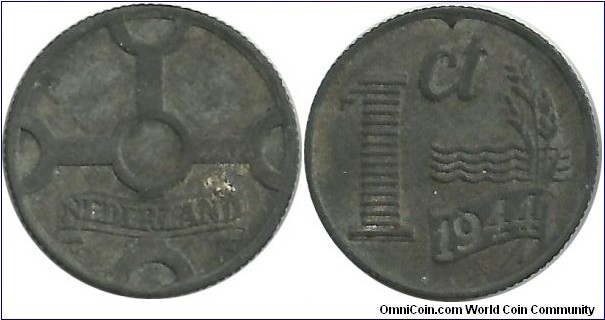
Netherlands 1 cent zinc, 1944
Weight : 2 g.
Diameter : 17 mm
Obverse : Cross and "Nederland" on ribbon
Reverse : Denomination and 4 waves and wheat ears
Edge : reeded
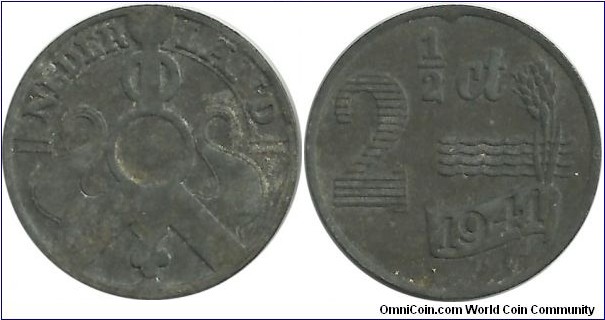
Netherlands 2½ cent zinc, 1941
Weight : 2.8 g.
Diameter : 20 mm
Obverse : Frysian "ûleboerd"
Reverse : Denomination and 4 waves and wheat ears
Edge : plain
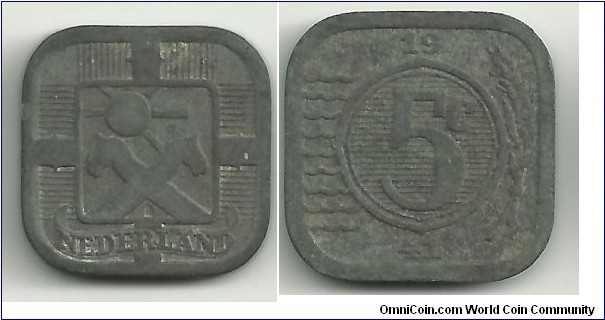
Netherlands 5 cent zinc, 1941
Weight : 3.6 g.
Side : 18 mm
Obverse : Saxon horse heads under a sun
Reverse : Denomination in a ring, left 9 waves and right one wheat ear
Edge : plain
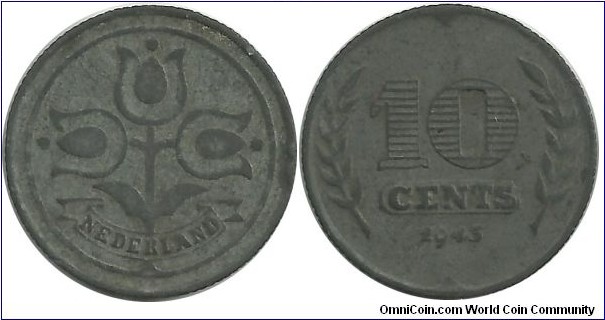
Netherlands 10 cent zinc, 1943
Weight : 3.2 g.
Side : 22 mm
Obverse : Three tulips
Reverse : Denomination between two twigs
Edge : reeded
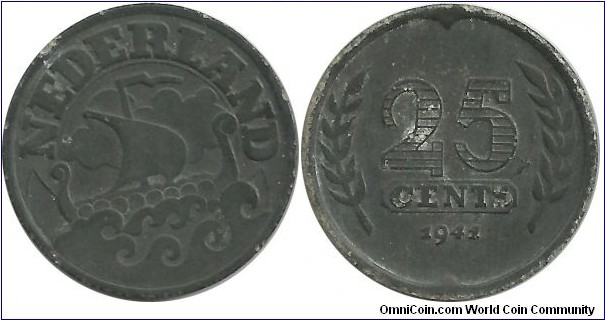
Netherlands 25 cent zinc, 1941
Weight : 5 g.
Side : 26 mm
Obverse : Sail boat, facing right
Reverse : Denomination between two twigs
Edge : plain
Sources:
"Geld van het Koninkrijk", H. Jacobi and B. van Beek
Akdeveli collection on OmniCoin
-
Dutch coins during WW2
In 1939, a shortage of guldens and rijksdaalders originated. This shortage and the continuing large demand for large silver coins and the smaller denominations, asked for a enormous production at the Mint. the demand for the smaller coins decreased in the summer, but after August 1940, it increased again. Specifically in 1941, there was a continuous shortage of the smaller denominations. Then there was also the plan of the Germans, to take nickel and bronze coins out of circulation, to use the metal in their war industry.
In the end of 1940, the Mint master was handed an "Anweising zur Erfassung der Münzen aus Kupfer, Nickel und Kupfer-Nickel-Legierungen in den besetzten Niederländischen Gebieten" (Instructions for capturing the coins of copper, nickel and copper-nickel alloys in the occupied Dutch territories) by a friend. In it, he read the plan to cancel these coins by 30 June 1940 and confiscate them. In an alleged attempt to solve the shortage of smaller denomination coins, the Mint then produces huge amounts of kwartjes, dubbeltjes, stuivers and centen (25, 10, 5 and 1 cent). A professional like Mint master Van Heteren obviously knew that this shortage would never be solved. But striking coins was his only option to remove the precious metals from the Mint. Although silver was not mentioned in the German instructions, Van Heteren feared that this metal was soon to be taken as well.
On request by the Minisery of Finance, the bars of sterling silver that were present in the Mint, were used for industrial purposes, and the Nederlandsche Bank provided large amounts of the large silver coins in order to strike the smaller silver denominations. To have all these coins before the fatal date in circulation, hard work was required at the Mint. The coin presses were set to a higher speed and starting in May 1941, two shiftst and later even three shifts were introduced. Result of all this effort: when the message arrived that all metal available at the Mint had to be handed over, no significant amounts were left! Unfortunately, in 1944 still a significant amount of metal was removed from the Mint and shipped to Germany. This metal came from handed in pre war coins.
After Mint master Van Heteren retired on 1 May 1941, dr. J.W.A. van Hengel was appointed as new Mint master. Later he was replaced and fired, being "unfit" for the job (unwilling to cooperate with the Germans).
Zinc coins
In Februari 1941, the German commissionar at the Nederlandsche Bank announced that preparations had to be made in order to replace the bronze and copper-nickel coins. On 5 June was also announced that the silver coins needed to ber subtracted from circulation. All smaller denominations had to be replaced by zinc coins. Only the half cent coins, which had no role in daily life, were allowed to stay in circulation; the amount of bronze in these coins was so little that a forced turn in and replacing the coins by zinc ones would give more work than profit.
3 July the diameters and weights of the future zinc couns were determined. Since all coins would be made of one metal, the serie required a different build up than the previous serie with three coin metals. Nico de Haas, editor of the weekly magazine Storm of the Dutch SS, was assigned to design drawings for the new coins. For the coins of 25, 10, 5, 2½ and 1 cent het fell back on "original Dutch symbols".
After approval of the patterns by the Secretary General of the Ministery of Finance, on 29 August 1941, production of the coins started. On 8 November, new examples were requested, this time for sending them to the Reichscommissioner Seyss-Inquart. He did not approve the 10, 2½ and 1 cent coins. The tree with three crowns on the 10 cent coins was not "German" and the hole in the 2½ and 1 cent coins to distinguish them from the other coins was considered shoddy. There were already 53 million of these coins struck; there were counted and packed and ready for shipment to the central post offices. They were all melted! As fast as possible new designs were made and approved and production started again, in order to be able to deliver the coins at 10 January 1942. In March, the copper-nickel stuiver and the bronze cent were retracted.
The 2½ cent and the dubbeltjes, kwartjes and guldens could not easily be retracted, These were often used in gas and electricity meters. Since the new coins had different dimensions, those could not yet be used in the meters. There had to be made zinc gas and electricity tokens, with the dimensions of the old coins. Nico de Haas made the designs for these tokes as well.
In August 1942, production of the tokens was ready, so retraction of the old coins could start. One had time until 19 September 1942 to hand in one's old silver, copper-nickel and bronze coins voluntarily. The response was so low that on 12 September a mandatory hand in was ordered: all coins had to be handed in before 5 October, or a high fine would be given or one could end up in prison. Alsmost everybody however kept his or her coins, only 7% was handed in.

Netherlands 1 cent zinc, 1944
Weight : 2 g.
Diameter : 17 mm
Obverse : Cross and "Nederland" on ribbon
Reverse : Denomination and 4 waves and wheat ears
Edge : reeded

Netherlands 2½ cent zinc, 1941
Weight : 2.8 g.
Diameter : 20 mm
Obverse : Frysian "ûleboerd"
Reverse : Denomination and 4 waves and wheat ears
Edge : plain

Netherlands 5 cent zinc, 1941
Weight : 3.6 g.
Side : 18 mm
Obverse : Saxon horse heads under a sun
Reverse : Denomination in a ring, left 9 waves and right one wheat ear
Edge : plain

Netherlands 10 cent zinc, 1943
Weight : 3.2 g.
Side : 22 mm
Obverse : Three tulips
Reverse : Denomination between two twigs
Edge : reeded

Netherlands 25 cent zinc, 1941
Weight : 5 g.
Side : 26 mm
Obverse : Sail boat, facing right
Reverse : Denomination between two twigs
Edge : plain
Sources:
"Geld van het Koninkrijk", H. Jacobi and B. van Beek
Akdeveli collection on OmniCoin
-
I have quite a bunch of Dominican Republic coins, most I have collected by asking the people I worked with if tey still had some old coins. Usually I they had some and I could get them.
They used to have the same denominations as the USA and Canada : 1 cent, 5 cent, 10 cent, 25 cent, half peso and peso, also the same sizes.
but, the peso devaluated quite a lot, so these small denominations aren't used anymore for a long time. When I first was there in 1999, they were already no longer used. It was a 1 peso coin that was circulating and for the rest notes (5, 10, 20 etc)A 5 peso coin was introduced too and since a few years they have 10 and 25 peso coins too.
-
Oh, I'm in, buth that was clear already, I think. I got my OmniCoin account back to work again, now all I have to do is deciding which will be my contestants and make some stunning photograhps of them....
-
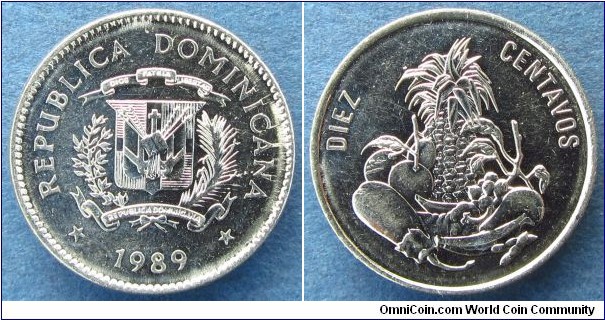
Republica Dominicana 1989
Diez centavos
Nickel clad steel
Reverse image: Indigenous fruits and vegetables.
Strange things happen at the top of the last letters in DOMINICANA.
-
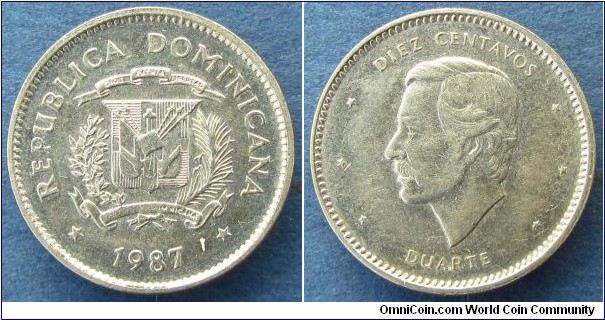
Republica Dominicana 1984
Diez centavos
Copper-Nickel, 2.5 g
This coin is one of a series of "human rights" coins, each denomination depicts one or more persons that fought for the human rights,
-
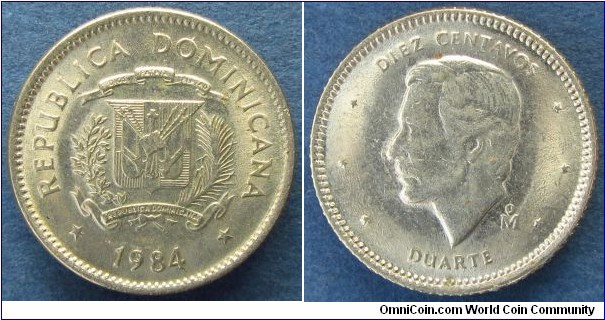
Republica Dominicana 1984
Diez centavos
Copper-Nickel, 2.5 g
This coin is one of a series of "human rights" coins, each denomination depicts one or more persons that fought for the human rights,
The 1984 is struck in Mexico City Mint.
-
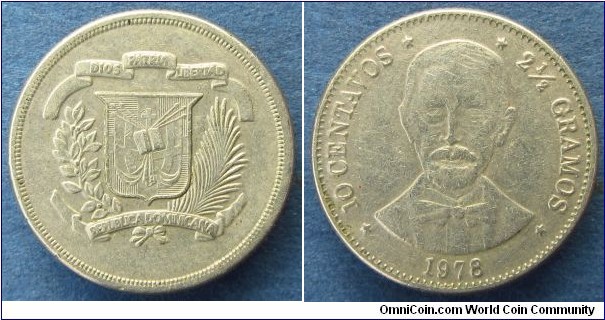
Republica Dominicana 1978
10 centavos
Copper-nickel, 2.5 g
Duarte is one of the "founding fathers" of the modern Dominican Republic, padre del patria.
-
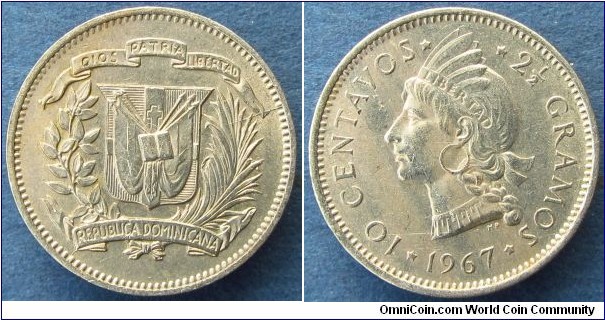
Republica Dominicana 1967
10 centavos
Copper-Nickel, 2.5 g
Notice the die break on the obverse, at almost 3 'o clock.
And another one at 7 'o clock, from the edge to the ribbon
[edit] forgot to mention the second die break[/edit]
-
I voted "Where ever the owner feels most comfortable".
- Since only that small plug is copper, and the rest not, I would definitely not place it in "copper".
- Bi-metal seems not appropriate to me either, as :
a - the plug is so small compared to the whole coin
b - the plug is not really part of the design
So, basically, I'm with Kevin
-
I took it with me to work today, we have a mail scale there, but it's got not enough resolution, can only show whole grammes. the digital indicator toggled between 1 and 2 gram, but I have no idea how accurate it is in that area, as the lowest value it can indicate is 1 g.
-
The diameter is close to what I found on that other website. I measured 25.8 mm, that site mentions 25 mm.
I cannot determine the weight properly, as I do not have a scale that is sensitive enough.This coin is pretty thin (0.75 mm) and thus quite light.
The edge is plain.
-
Not yet...
I just got one coin, I intended to order a rol, but the Mint added quite a premium on these: EUR 75 for a roll of 25 coins,


PCI2013 Copper - Group 6 - Round 1B
in PCI2013 Archive
Posted
tough one, I don;t really care for either of them. the 2p has a good old fashioned size though.